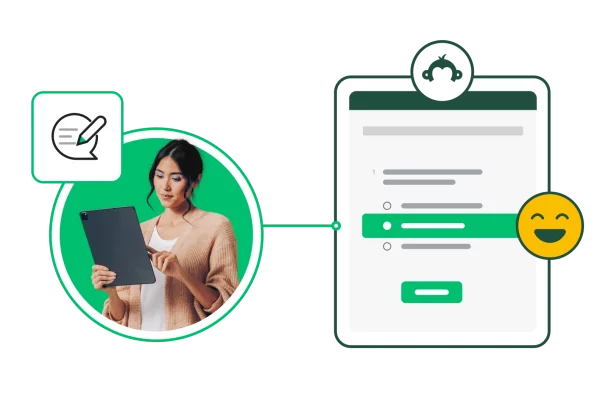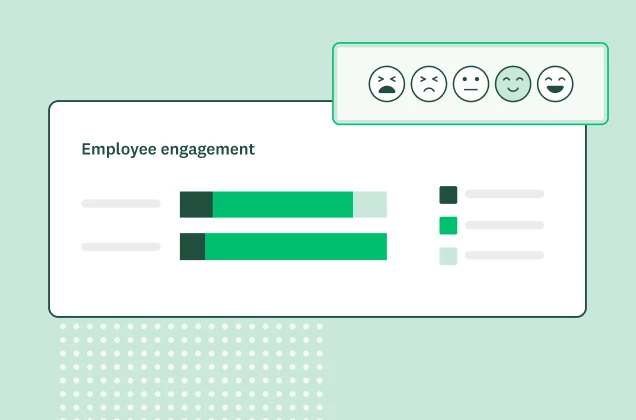How learning and development improves employee engagement
Learning and development programs are a vital resource to enhance employee engagement, drive satisfaction, and support your workforce.

Learning and development programs are crucial for organizations in today's fast-paced digital world. While some hesitate to invest, many HR professionals see a link between learning and development (L&D) and employee engagement.
Opportunities to learn and grow are extremely important to millennials. According to SurveyMonkey research, career growth is the most important factor for them when choosing a job, with 80% saying they expect a promotion within the first two years.
In this article, we’ll explore the close link between L&D and employee experience, demonstrating how the former positively impacts the latter.
Why is L&D important?
Learning can be a constant pursuit, from attending a business seminar to developing new skills to taking self-guided online courses. Businesses and employees benefit when organizations demonstrate their commitment to personal and professional growth.
Here are a few reasons why learning and development programs are essential in an organization:
Improve employee performance
Learning and development programs give employees new skills to apply directly to their job roles. Considering that only 27% of employees think their career progression opportunities are excellent, most companies should spend more time providing advancement opportunities.
Instead of having to look externally for new hires with the skills you’re looking for, you can “keep it in the family” and teach your employees even more about how to succeed in their roles, all while boosting engagement and job satisfaction.
By helping to upskill your workforce, your employees will be better equipped to tackle challenges, drive innovation, and contribute to the company's overall success.
Boost employee retention
In our recent study of HR professionals, over half (55%) said training is the most crucial investment in employee experience. 26% cite a lack of growth opportunities as the top driver for employee turnover. The challenge for HR pros is to provide development opportunities that can directly impact an employee's ability to advance within their career.
L&D teams must collect employee feedback before and after training sessions or programs to create effective, tailored training programs. This input provides valuable insights into areas where training is most needed and the effectiveness of existing programs.
By developing employee-centric training materials, organizations can demonstrate their interest in employees' professional growth and future within the company.
Build a leadership pipeline
Offering learning and development opportunities for your employees can give them the skills they need to grow and develop within the organization. When working with employees over a long period, you can take an active role in making employees feel valued and supported, providing a clear path for career advancement.
By implementing L&D opportunities in your organization, you create a culture that attracts and retains top talent. This signals that your company invests in growth and, in turn, attracts ambitious candidates. Developing such programs also boosts retention among your most high-performing team members by offering them new pathways to success.

Why is employee engagement important?
Employee engagement is one of the most impactful metrics you can track when looking to improve revenues and drive business success. Your employees are the heart of your organization, influencing every decision and serving as the face of your company to customers.
When engaged employees are more productive and committed and likely to deliver better customer experiences, they directly contribute to your organization’s bottom line.
Here are a few reasons why employee engagement is so important.
Related reading: The first step to launching your employee engagement program
How does L&D impact employee engagement?
As we’ve noted, learning and development programs directly impact employee engagement because they help nurture a positive work environment where employees feel valued and supported. According to LinkedIn, a lack of professional development is the number one reason employees leave companies, with 94% saying that they would stay at a company longer if it invested in their learning and development.
Since millennials, who comprise most of the workforce, strongly view professional development as a top priority, investing in L&D initiatives becomes even more crucial for organizations looking to boost engagement.
L&D isn't just a singular focus area in fostering a positive employee experience (EX); it is a core component that significantly enhances the overall employee experience. By prioritizing L&D initiatives, organizations can empower their employees to grow, learn, and develop essential skills, thus creating a more engaging, supportive, and fulfilling work environment.
This, in turn, can lead to increased employee satisfaction, higher levels of motivation, and improved performance across the organization. Investing in L&D initiatives isn't just a valuable asset for individual employees; it's a strategic investment in the organization's collective success and growth.
Improve job satisfaction
Learning and development opportunities improve job satisfaction by advancing employees in areas that align with their professional values and goals. This, in turn, leads to more satisfaction, as employees see their work as meaningful.
Recent SurveyMonkey research reveals that as many as 85% of employees are satisfied with their jobs. However, several key factors can influence an employee's job satisfaction, including recognition and rewards—82% of employees are happier when they're recognized at work.
Boost employee motivation and morale
Employee motivation is the baseline level of enthusiasm that every employee brings to work each day. This motivation could come from internal factors, like enjoying working with their team and wanting to impress them. It could also come from extrinsic factors, like wanting to prove they deserve a promotion.
For those with internal motivators, the ability to prove their knowledge and enhance their skills will allow them to help those around them more. For those with extrinsic motivations, learning new skills will help them get hands-on experience that could help them advance their professional goals.
Offering learning and development opportunities is an excellent way of boosting employee motivation. These learning opportunities give employees something to feel motivated about.
Enhances employee value proposition
Enhancing the employee value proposition (EVP), the complete package of benefits, compensation, and perks an organization offers, is critical to attracting and retaining top talent.
The global workforce is experiencing a surge in employee turnover. Recent SurveyMonkey research reveals that the leading reason is employees feeling like they’re not adequately compensated. This underscores the importance of regularly assessing and enhancing your EVP to ensure it’s competitive with prospective and current employees.
Organizations should prioritize open communication with their employees to better understand their needs and expectations. By gathering employee feedback and insights, companies can identify areas where their EVP may fall short and take proactive steps to improve it.
Supports continuous learning
Another way L&D programs boost employee engagement is by creating an environment of continuous learning.
Environments of continuous learning also help to foster a growth mindset. Simply put, a growth mindset is a cultural belief that anyone can learn and grow and that learning and growing are key to people’s happiness and success.
For example, a software company might offer regular coding boot camps, technology conferences, and hackathons to keep employees up-to-date with industry trends and best practices.
With happier employees, you’ll see increased levels of job satisfaction, driving engagement. Moreover, you’ll help out those 48% of employees who feel like they don’t have a path in an organization. Providing a learning culture always gives them something to work on to improve.

How to improve engagement with L&D
Now we understand why learning and development programs are valuable to an organization, let’s discuss how we can use them to improve engagement.
Create a company-wide learning culture
Making learning a priority in your organization will help attract candidates who value education. By encouraging open discussions between your employees about the specific learning experiences they’re currently pursuing, you help to place a focus on learning in your company.
For example, you could carve out an hour or two each week when employees can focus entirely on their learning opportunities. This approach could be well-structured to give people an easier Monday morning or Friday afternoon at work.
Implement coaching and mentoring programs
Learning and development programs don’t stop at individual learning programs. Another effective L&D format is implementing coaching and mentoring programs for your employees.
It's important to have mentors for employees seeking promotions and to invest in coaching and mentorship programs. Dedicate time for high-performing or senior employees to mentor and coach others and create personalized learning paths for employees.
Not every employee learns in the same way. Understanding that different employees will have distinct learning styles helps you pair workers with the best learning course for them. By actively seeking employee feedback, organizations can gain valuable insights into how their workforce learns best and tailor their L&D initiatives accordingly.
Invest in employee feedback
To ensure the relevance and effectiveness of learning and development programs, it is essential to seek input from the employees actively participating. Don’t overlook the power of surveying employees to understand their experience.
Surveys are one of the most powerful tools for gathering employee feedback. By asking employees to share their thoughts and experiences, HR teams can better understand what works well and what areas need improvement in their L&D programs.
Your business can use employee feedback surveys to rapidly and effectively collect insight from your employees. Here are some useful surveys you can use for L&D research:
- Employee pulse survey: Gather real-time insights about employees' feelings at work. Using these can help pinpoint what learning opportunities employees engage with and which they’d like to see in the future.
- Professional development survey: Establish the core skills employees need to thrive. With this survey, you can identify employees most interested in L&D and connect them to the right opportunities.
- Training course evaluation survey: A training course evaluation will allow your employees to share their thoughts and experiences on an L&D opportunity they’ve taken. Identify areas of strength and weakness in your training initiatives, informing decisions and improvements for future offerings.
- Employee satisfaction survey: Measuring your overall employee satisfaction will identify why employees may feel unsatisfied at work. Catching these employees early will help you point them toward support in your organization and retain them for longer.
Your learning and development programs can improve over time when you listen to your employees, implement their feedback, and close the feedback loop.
Discover how SurveyMonkey can help you build better L&D programs
Learning and development programs are a vital resource for both employees and employers. Understanding the power of L&D to enhance employee satisfaction, drive engagement, and improve retention will show your organization why it should invest in education.
Learn how SurveyMonkey can help you discover which L&D opportunities your employees value and want to see more of. Take the first step towards better learning and development programs.
Discover more resources

HR toolkit: Make employee experience your competitive advantage
HR leaders can use this toolkit to help drive exceptional employee experiences.

Employee forms: use cases and templates
Learn how to use employee forms to improve essential HR processes, boost employee experience, and drive change. Discover best practices for creating your own employee forms.

From insights to impact: Leveraging curiosity to build more inclusive workplaces
A discussion at how to create a more equitable workplace.

Belonging and inclusion survey
Measure what drives inclusion at your company with our expert-designed survey template.